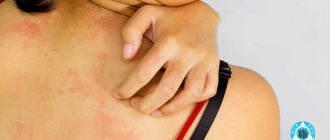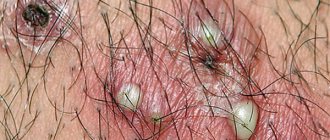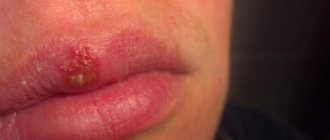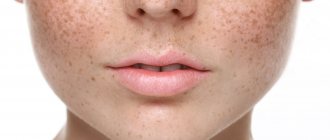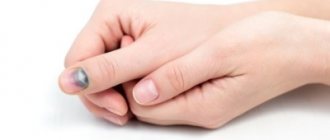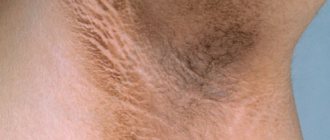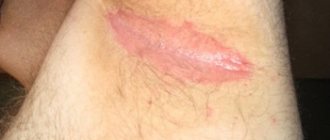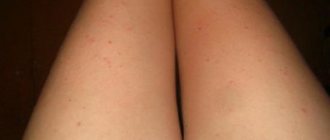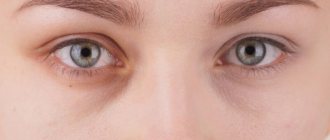The types of skin diseases are very diverse. They differ in location, nature, nature and degree of manifestation. The most common skin reactions are rashes and redness. Thus, the skin often reacts to certain types of allergens, as well as certain diseases. It is especially unpleasant when the skin begins to redden and peel on the elbow or knees, because this situation often leads to microtraumas and significantly affects the quality of life. If you don’t know why redness appears on the bend of the elbow, why they are dangerous and how to deal with them, but would really like to know, then this article is just for you.
Red spots on the hands not only indicate the presence of obvious health problems, but also cause internal discomfort due to their lack of aesthetics. Having such imperfections, you have to limit yourself in your choice of clothes and activities. However, in order to definitely get rid of such troubles, it is worth understanding the problem deeper.
Causes of redness
In order to determine with high accuracy the cause of unpleasant stains, it is necessary to contact a specialist. Even outwardly similar spots can be the result of completely different pathologies. Accurate diagnosis of redness in the bend of the elbows in an adult requires a thorough examination, as well as tests, since they can cause many types of pathologies.
Psoriasis
Most often, psoriasis is considered as the main type of ailment for redness. This is a chronic disease that cannot be completely cured. The patient can only relieve the symptoms using well-chosen therapy. In the acute period, psoriasis is characterized by the appearance of peeling in the form of large scales and itching. Some factors can trigger a relapse:
- consumption of alcoholic beverages;
- poor nutrition;
- some types of household chemicals;
- some medications;
- climatic conditions;
- season.
As soon as the first signs of the disease are detected, it is advisable to begin the fight against it . In this case, there is a high probability of slowing down the process at the initial stage, then the affected area will be minimal.
Hypothyroidism
When the body stops producing thyroid hormone in normal quantities, diseases called hypothyroidism appear. It is characterized by reduced circulatory activity and a weakening of many biological functions of the body. This dynamic causes the development of various pathologies.
One of the obvious visual manifestations of hypothyroidism is the appearance of dark, scaly spots on the elbows. To refute or confirm this disease, it is necessary to take a test to determine the level of thyroid hormone in the blood. If its content exceeds the norm, then we can talk about the presence of a deviation. In this case, therapy is carried out by an endocrinologist. The main signs of the disease can be treated with medication; special creams and ointments are used to get rid of skin reactions.
Hives or allergic rash
Another leader in the presence of red spots on the body is urticaria or an allergic reaction. Its characteristic feature is raised red spots. This rash occurs for several reasons:
- direct contact with the allergen and subsequent reaction at the site of contact;
- reaction of the immune system to a medical drug or product. In this case, the localization is varied, and the reaction itself is noticeable after a day or two.
With urticaria, redness on the elbows in older people and in younger patients is bothersome with itching and swelling.
As the rash heals, it takes on a scaly texture.
During the treatment process, medications and medicinal ointments are used, and contact with the allergen is also excluded.
Other infectious pathologies
There are other types of diseases whose symptoms are similar. In this case, pathologies are caused by a virus, parasite or fungus. Among the most common:
- scabies. It is provoked by the scabies subcutaneous mite. To become infected you must have contact with a carrier. A characteristic feature is nodular paired rashes;
- lichen. Caused by a virus or fungus. The rashes, which vary in color, are localized in different places of the body, often on the stomach, thighs, and back.
- dermatitis, eczema. This inflammatory process occurs due to hormonal imbalance, an allergic reaction, and a weakened immune system. Manifestations most often take the form of white, scaly spots;
- candidiasis, mycosis. The lesion is fungal in nature and most often finds itself in the perineum, armpits, elbow bends, and so on. As a rule, a small rash appears in large foci, which itches and flakes off.
Thus, in order to make a diagnosis as reliably as possible, it is necessary to undergo an analysis, often even more than one. Attempts to independently treat redness on the inside of the elbows in an adult often not only do not help, but also aggravate the situation.
Diabetes
In diabetes mellitus, the function of the endocrine system is disrupted and an imbalance occurs in the production of the hormone insulin. Glucose, entering the blood, is not processed properly, but accumulates. This causes metabolic disorders, provokes dehydration, dryness, the appearance of spots and rashes. A particularly characteristic sign of the presence of diabetes mellitus is the appearance of flaky spots on the elbow.
Dysbacteriosis
With poor diet and lifestyle, a person often develops dysbiosis. With this disease, metabolism is disrupted due to a disorder of the microflora of the gastrointestinal tract. Such dynamics disrupt the usual process of removing toxins from the body. Against the background of pathology, as well as a lack of vitamins and other useful microelements, all sorts of manifestations occur on the skin in the form of pigmentation, spots, redness on the inside of the elbow. In this case, it is necessary to approach therapy comprehensively and work on the overall health of the body.
Rash on the crook of a child’s arm: photo, itches, causes and what to do
A rash on the crook of a child's arm is not a very typical occurrence and can be the result of a variety of causes - from a microbial or bacterial infection to a hereditary disease or food allergy. You should not look for the answer from the photo, especially if the rash itches. A doctor of the appropriate specialty should determine the reasons and what to do.
- Visual symptoms
- Most likely reasons
- Pathological causes
Visual symptoms
A common mistake that parents make when a rash appears on the crook of a child’s arm is an attempt to independently determine the nature of the pathology based on terrifying photos posted in the World Information Space. They are done at a significant stage of development, when skin manifestations have already transformed from their original appearance and have acquired significant differences from the initial symptoms.
Rash is a general collective term to denote pathological manifestations on healthy skin (primary) or new ones that form in place of existing ones. The doctor can make certain diagnostic assumptions based on the picture he sees, but for an accurate diagnosis he needs data from the tests performed.
Skin is the largest organ complex in the human body. It ensures the interaction of an open system with the environment, maintains a certain temperature and is closely connected with internal organs.
Depending on the cause of the rash, pathological elements can be cavitary (hollow inside and filled with variable fluids: serous, purulent, bloody) or simply rise in tubercles, large or small. The appearance and nature of the rash depend on the pathological process occurring inside the body or directly in the dermal layer.
Also read: Nazivin for children from 0 to 1 year: instructions
Elbow and knee joints in adults and children are subject to the greatest load. Therefore, the skin covering the outside of the bony protrusions is practically devoid of sebaceous glands.
It is rough to the touch, and the inside is especially vulnerable, tender, and prone to irritation.
Some sources can count up to 70 reasons that can cause rashes in a child and an adult, but if you combine them into large conditional groups, then there are three main ones: infections, allergic reactions and vascular pathologies.
Often, primary elements on the crook of the arm, caused by insufficient care, insect bites, parasites or poor hygiene, are mistaken for a pathological rash.
There is clearly not enough information to make a diagnosis using the wording “rash on the crook of a child’s arms.” An allergist, dermatologist or infectious disease specialist focuses not on its location, but on its appearance, intensity, color, distribution and characteristic symptoms - temperature, intoxication, general condition of the child.
Most likely reasons
The child’s body is more vulnerable because in the initial period after birth, the immune system is not sufficiently developed and depends on mother’s milk. After breastfeeding ends, there comes a time when the risk of infection or an allergic reaction increases.
The appearance of a rash is most often associated with insufficient hygiene measures or defects in care:
- single red bumps, especially in warm weather, are associated with insect bites - just buy repellent or put a net on the windows so that the child does not suffer from itching;
- multiple rashes may be a consequence of the presence of bedbugs or scabies mites, body lice - despite the parents’ confidence in the impossibility of this, the prevalence of parasites and the likelihood of infection are quite high;
- contact with poisonous or burning plants can cause blisters and even blisters in a child who walks unattended and visits places where they potentially grow;
- allergic dermatitis develops in children who come into contact with household products, potential allergens, or who are constantly taking medications;
- an allergy to cold appears not only in the crook of the arm: in children who are not dressed warmly enough, or who live in a cold room, hives develop - a consequence of the unsatisfactory ability of a small organism to thermoregulate;
- diaper dermatitis is inevitable if the baby is not washed often enough, and parents ignore the first signs of irritation and do not use recommended remedies;
- a rash on the inside of the arm in an older child may be a reaction to tight and rubbing synthetic clothing, poor-quality laundry detergents, or poor rinsing;
- the appearance of primary elements during puberty is sometimes a consequence of a hormonal surge, a lack of essential vitamins and microelements, and poor nutrition with preservatives and dyes.
Also read: Rash on the back of a child: photo with explanations
Children, especially small ones, cannot control hygiene standards themselves, and infants cannot even complain about the inconvenience they are experiencing or explain verbally what is bothering them.
Their health depends on the attention of their parents. It is not for nothing that every care guide strongly recommends carrying out hygiene procedures, choosing special detergents and laundry products, and constantly monitoring the baby’s condition.
Pathological causes
The presence of the disease can be guessed by several signs: the rash begins to spread further, often throughout the body, and changes. Additional symptoms manifest themselves: the temperature rises, the child becomes whiny and lethargic, loses interest in toys and games, complains of aching joints or a headache, which becomes a natural consequence of intoxication.
Enterovirus infection, measles, scarlet fever, chickenpox begin with small, seemingly harmless rashes that closely resemble reddish pimples. They can appear in different locations. At first, the rashes are not very numerous. You should not try to make a diagnosis yourself, based on photos in online publications.
A dangerous infection can progress quickly.
You can make initial assumptions based on the shape of the rash: spots - most often dermatitis, blister - allergies, chickenpox or eczema, blister - insect bite, blister - burn or parasite bite, most often a blood-sucking one, elbow bends, back and groin in red rashes, with subsequent inflammation and blue discoloration - scarlet fever.
You can turn to your local pediatrician for help, he will give you a direction on which doctor to see - an infectious disease specialist, an allergist, a dermatologist.
General analyzes may be required to make initial assumptions. If the cause of the rash is due to defects in care, consultations and practical advice will be sufficient.
In any case, the child’s health will depend on timely treatment.
If the baby’s condition worsens before our eyes - the rash spreads, a rise in temperature, and symptoms of intoxication are observed, it is better not to wait until the morning to go to the clinic, but to call an ambulance.
Such manifestations indicate dangerous reasons for a skin reaction and may require immediate assistance, removal of symptoms of toxin poisoning, and administration of medications in a hospital setting, under medical supervision.
Source: https://deti-zdorovy.ru/simptomy/syp-na-sgibe-ruki/
How to distinguish allergies from dermatological diseases?
All skin reactions characterized by rash, itching, redness, peeling can be equally related to allergic reactions or dermatological pathologies. It is impossible to determine a specific case with one hundred percent certainty only on your own. It is imperative to contact a specialist who, using a comprehensive diagnostic method, will be able to determine the disease.
Don’t rush to diagnose yourself, but still pay attention to what new foods may have appeared in your diet. you have been prescribed a new drug, and the rash is an allergic reaction to its components. If the possibility of allergies is excluded, then we can talk about dermatological diseases. In any case, to begin treatment for inflammation of the elbow with redness, you must contact the appropriate specialist as soon as possible, namely a dermatologist, who, if necessary, can refer you to other doctors, depending on the results of the studies.
Treatment of elbow allergies
If you find that your elbows are rough and there is a rash on the inside of them, then you need to conduct an initial self-diagnosis. Do you remember what unusual thing you ate recently? Perhaps you've tried a new beauty product or adopted a pet. If changes appear immediately after contact with any substance or object, it is likely an allergy.
Try to see a doctor as soon as possible. However, while waiting for a consultation, you can try to help yourself.
If itching and burning appears on the inside or outside of the elbow, antihistamines are usually prescribed. They suppress the action of active substances produced by the body as a result of a complex cascade of reactions triggered by the allergen, and therefore are able to relieve unpleasant symptoms.
You can purchase one of the following products at the pharmacy:
- Fenistil,
- Tavegil,
- Suprastin.
These are the most popular drugs. They are produced in the form of tablets, ointments, and syrups.
Another treatment option is glucocorticosteroid ointments. However, despite their effectiveness, use without consulting a doctor is contraindicated. This is due to the fact that they suppress inflammation, and if an infection is added to the allergy, it may spread or become chronic. GCS preparations include, for example, Laticord and Dermovate ointments.
Remember that every medicine has contraindications and side effects. Be sure to consult your doctor before taking medications.
Treatment of a child for elbow allergies
First, you need to eliminate the allergen that caused the unpleasant rash and redness. As we have already said, this can be a food product, hygiene products, animal hair, and so on.
Since the child is still small, eliminating the allergen will have to be done through trial and error. The fact is that the immune system of a child under 3 years of age is just developing, so, unfortunately, it will not be possible to detect an allergen using various laboratory tests. Newly introduced complementary feeding products, as well as new cosmetics, are the first to come under suspicion. Milk, fresh baked goods, chocolate and coffee, and seafood should be excluded from a nursing mother’s diet.
Photo: Polysorb effectively removes allergens from the body
You should carry out wet cleaning every day in the room where the baby is, and also remove pets from the room at least temporarily.
Simultaneously with the introduction of a hypoallergenic diet and adjustments to everyday life, you can start giving the child sorbents (for example, “Smecta” or “Polysorb”) if the food nature of the allergy is identified.
In very rare cases, with a severe allergic reaction, the baby is prescribed antihistamines. Many people mistakenly believe that they can cure allergies, but this is not true. Antihistamines help temporarily relieve unpleasant rashes, redness and itching.
You should not “prescribe” such medications to your child yourself, because they can make the situation worse.
Traditional methods of treating elbow allergies
You can also use some folk remedies that will relieve you of rashes on your elbows due to allergies. You may have heard from your parents or grandmothers that a decoction of celandine will help you say goodbye to allergy symptoms. These are not rumors at all, they are true.
- 5 grams of celandine (dry or fresh);
- 50 ml boiling water.
Pour celandine with water and leave to infuse for 20 minutes, after which it is recommended to take a bath with this decoction. The duration of the bath is no more than 20 minutes. This method is not recommended for children.
In addition to celandine, a decoction of chicory and sea buckthorn oil are used:
The recipe for chicory decoction is approximately the same as for celandine. Only the chicory should be strained. The decoction can be added to the bath, or you can wipe yourself with it once a day.
Apply sea buckthorn oil to the affected area of skin as needed - if itching or other unpleasant sensations occur. It is usually necessary to carry out several such procedures until the rash completely disappears.
Babies can be bathed in baths with chamomile and string; it is permissible to apply lotions to areas with allergies. If, in addition to the rash, there is dry skin, a good remedy is to use emollients.
General rules and methods of treatment
This or that principle of treatment is selected depending on the nature of the disease itself, but there are some general norms. So, if it is known for sure that the cause of the rash is an allergy, it is imperative to exclude the possibility of repeated contact with the allergen. They also start taking antihistamines, which are prescribed by the attending physician.
To relieve local reactions on the skin, special creams, ointments and gels are widely used. There are a large number of similar drugs and they all have a different nature of action, so it is important in this case not to self-medicate, but to trust the opinion of a specialist. Peeling often occurs on the hands, which can also be treated with ointments; you will find more detailed information on this topic in the article “Causes and methods of caring for dry elbows.” Unwanted skin rashes can be caused by various factors, and serious problems cannot be excluded, which is why it is so important to contact the appropriate institutions in a timely manner.
Traditional medicine recipes
Some types of rashes can be successfully treated with traditional methods using lotions. Celandine is most often used, since this plant has a whole range of beneficial properties, including bactericidal, wound healing, and antifungal. The easiest way to prepare the plant for use is to pour boiling water over a tablespoon of celandine, leave for half an hour, and then use the resulting infusion as a lotion. Coltsfoot, chamomile, wild rosemary and chicory are used in the same way.
In addition to infusions and decoctions, herbs are used to make rubs. For example, take dried geranium leaves and add them to olive oil. Let the mixture brew for a week in a cool, dark place, and then move the container to normal daylight for a month. After this, rub the resulting oil onto the problem areas.
In addition to this homemade oil, pay attention to pharmacy essential oils: tea tree, rose, jasmine. They also do an excellent job. But remember that treatment of elbow inflammation with folk remedies must begin with checking for allergies.
How to treat itchy hands
If your hands itch as a result of an illness, then after assessing the symptoms and stage of development, the doctor prescribes specialized treatment. For skin diseases, local gels and ointments are used - Lorinden, Fluorocort, Sinaflan. Additionally, taking vitamins A, D, E is indicated to restore the skin.
First aid for itchy skin
By eliminating the external causes of pruritus, you can cope on your own. For skin diseases, you can use folk remedies that relieve pruritus.
- Burdock root. Pour a tablespoon of chopped root into 500 ml. water and cook for 10 minutes. The decoction is taken half a glass twice a day. Treats skin diseases.
- Dill seed. You will need a teaspoon per glass of boiled water. Drink in small portions throughout the day.
- Nettle. Brew 2 large spoons with a glass of boiling water. After infusion for an hour, drink this amount of infusion per day. Helps with eczema.
- Mint. Make a lotion on itchy areas with mint infusion. To do this, take a large spoon of herbs and 500 ml. boiling water pour in and use after an hour. The infusion can be used for warm hand baths. Used for skin lesions.
Don't put off visiting your doctor if your palms are itchy.
Video: causes of itchy hands. Be healthy and let your palms itch only for money!
Useful tips
The best option in any situation is to try to prevent the disease. Pay close attention to your diet, do not neglect the recommendations of doctors, take care of your hygiene, your well-being, and in case of the slightest deviation from the norm, always consult a doctor.
If redness has already appeared, and the doctor has not yet prescribed treatment, try to exclude everything harmful, in your opinion, from your diet and everyday life. It is advisable not to overdry already injured skin, so use gentle shower foams and brushes, washcloths, etc. on the damaged areas. The use of soft scrubbing agents, as well as light nourishing creams, is allowed. However, to answer the question of why redness appeared on the bend of your elbow specifically for you, you will still have to turn to a professional.
